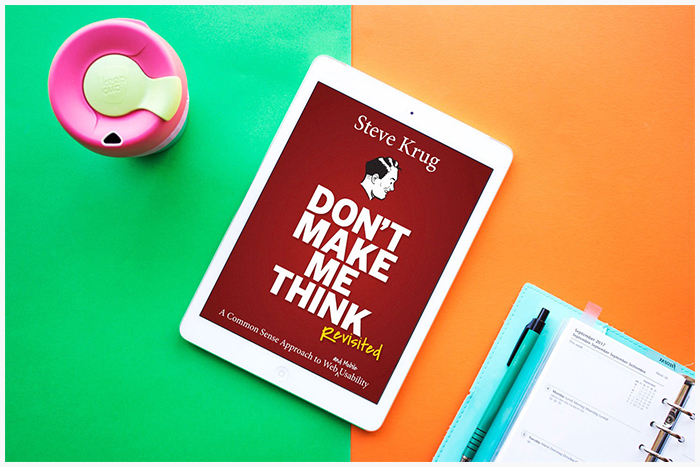The irony of the whole thing is pretty thick, really: web designers (or would-be web designers), who have plenty of technical savvy and have a world of information available at their fingertips, using a centuries-old medium to glean information. But books are a concentrated source of information, built on research and solid practical experience.
They save a lot of time that would otherwise be consumed in searching across hundreds of websites for the same information, and they are much less expensive than the equivalent courses. Here, then, are the 6 books every web designer should read in 2018.
Timeless Web Design Books
If you really want to understand web design in order to jump-start your Internet marketing, then don’t neglect those books every web designer should read, while not published in 2018, have stood the test of time and proven themselves immensely valuable to developers. These books usually come down a little heavier on the side of theory than practical application. But that’s good. If you know why you are doing something, then you will know that much better how to do it.
Don’t Make Me Think, Revisited, Steve Krug

First published several years ago and now updated, this is the most often recommended book on web design. Krug is a long-time usability consultant and spent 15 years as a user advocate for companies like Netscape, Apple, Lexus, and AOL. Without a doubt, then, he has a firm grasp on all aspects of usability.
As an information architect and UX expert, Krug champions one design principle above all others – that web pages should be as self-evident as you can make them. A user should be able to understand a page and its main message almost immediately. There should be no need for explanation. So Krug helps designers see things from the user’s perspective in order to carry out design accordingly.
Design for Hackers, David Kadavy

To truly understand what works in web design, you also need to understand what doesn’t work and why it doesn’t. Drawing on examples from Impressionist painting and Renaissance sculpture, Kadavy tackles this issue with plenty of illustrative examples.
The author’s goal in Design for Hackers is simply to help people understand good design. Along the way, Kadavy addresses where good design comes from, how it can be produced/reproduced, and what it takes to be a great designer. He also treats the various components of design and page appearance, including composition, proportion, color, white space, and typography. This a book for both the novice and the experienced developer.
Communicating Design, Dan M. Brown

There is more to web design than learning the principles and mastering the tools. You also need to be conversant with all the processes, especially documentation for clear communication when a team is involved. And that’s what this book is all about.
Web design today involves a multiplicity of processes demanding a variety of skills and usually with many people involved. For all these pieces to fit together, everyone has to be on the same page, which requires clear communication. And that communication flows from well-executed documentation of all the parts of the design process. Brown can help you stay organized with his explanations of workflow charts, project briefs, sitemaps, and wireframes – so that the resulting documents actually become useful tools themselves.
2018 Web Design Books
Now we come to the must-read books of 2018, books that address web design as a crucial element of marketing. The old standby books every web designer should read are good, but web design evolves so rapidly in some respects that you must look into what has been recently published.
Web Development and Design Foundations with HTML5, Terry Felke-Morris

This is the 9th edition, updated for 2018, of this classic textbook. Web Development and Design Foundations with HTML5 is the go-to resource for developers who want to learn all about the latest techniques for creating cascading style sheets and code. And this book even includes practice exercises and games.
Basically, Web Development and Design Foundations with HTML5 introduces and explains a host of HTML and CSS topics – text and color configuration, page layout, and design topics such as accessibility and web standards. In addition to the “hard” skills like HTML5, CSS, and JavaScript, Felke-Morris also addresses some of the fundamental web development issues surrounding Internet marketing, such as design, e-commerce, and promotion strategies. The emphasis on hands-on learning and practice makes this 9th edition a valuable book for those wanting to learn design.
Designing with the Mind in Mind, Jeff Johnson

Although it was published four years ago (the latest edition), we’re including this book here because it is still so timely and utterly relevant and, well, indispensable. For it is an in-depth study of cognitive psychology as a way to get a handle on effective design.
Johnson delves into perceptual and cognitive psychology and offers UI design principles based accordingly, with the goal of providing guidelines that make intuitive sense. Understanding the psychology underpinning effective UI design is essential for creating effective designs that appropriately apply the guiding design principles. This latest edition even includes chapters on hand-eye coordination and attention span.
Responsive Web Design with HTML5 and CSS3, Ben Frain

And let’s not forget mobile-friendly web design. In Responsive Web Design with HTML5 and CSS3, Frain emphasizes the use of HTML5 and CSS3 as tools for creating sites that flow seamlessly from desktop/laptop to a smartphone.
Frain’s goal is to help you understand the methodology involved in building sites that are “responsive and mobile first.” Mastering the latest in design using HTML5 and CSS3 will allow you to design sites that display effortlessly and pleasingly on any and all devices that access them. After reading this book, you’ll come away with an understanding of responsive design and why it’s so critical for modern web development.
Web Design Books Supplement
Reading the right books every web designer should read it’s probably just not enough. For one thing, publishing is just too slow to keep up with the latest developments and trends in web design (let alone the rapid evolutions in marketing, which are often tied to web development). So, basically, you will need something to supplement your web design reading – if, that is, you want to make cutting-edge websites for the new age of Internet design.
The best way to access that necessary supplemental knowledge is by calling on the expertise of a design firm recognized for quality, results-getting design work. Just look for a company and a team that specializes in creating custom-tailored, business-unique sites based on sound design principles. Remember: a website has to be a lot more than just a pretty face in cyberspace.


